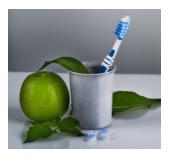|
Office Location
200 Elm Street
Pittsfield, MA 01201
Ph: 413.464.8200
Fax: 413.464.8205
contact@matthewballingerdds.com
Make an Appointment
New Patients
 |
To maximize your time with us, fill out your patient forms ahead of time!
Click here!
|
|
|
 |
|
|
|
|

|
 |
Dental Health and Your Diet
Sugar is the main cause of dental decay when there are bacteria present. More
significant than the amount of sugar you eat is the frequency of consumption.

Probably the worst thing you can do to your teeth is to drink a soda and
have a sip every few minutes over a long period of time; the same is true for
snacking. It is recommended that if you want to have a snack or soda or juice it
is better to have it after food, as dessert, or have it in one sitting. Eating
or drinking something sweet over an extended period of time creates a constant
supply of sugar for bacteria that causes tooth decay!
It is important to be aware of all the sources of sugar that are out there.
It is not just everything that is sweet, but anything that can turn to sugar
like pieces of bread. Cutting down your sugar intake is good for cavity
prevention, as well as your general health.
But what about when you have to have sugar? The best way to avoid cavities
is to prevent the sugar from staying next to your teeth. Brushing after eating
sugar, rinsing your mouth with Fluoride mouth wash, or chewing sugarless gum can
help. However, nothing has the effect of avoiding sugar!
Is there any kind of food that prevents tooth decay? Well, not really. Some
people believed that chewing foods like apples and carrots may have some plaque
removal effect, but they still contain some sugar so any advantage is not clear.
Another group of food that causes significant damage to teeth structure is
acidic foods. If in frequent contact with teeth, things like lime, lemon, and
grapefruit can cause serious irreversible damage (erosion) to your teeth.
If you have any questions about diet and dental health
and you live in or around the Berkshires, Pittsfield, give us a call today!
Go back to Patient Education
|